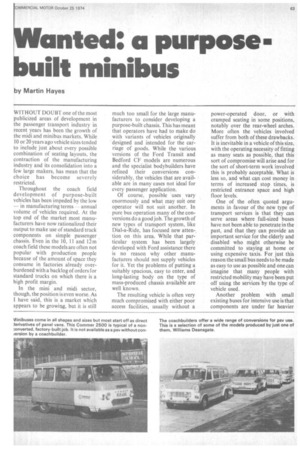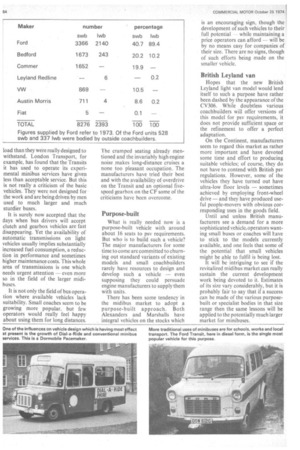anted. a purpose uilt minibus
Page 65

Page 66

If you've noticed an error in this article please click here to report it so we can fix it.
by Martin Hayes
WITHOUT DOUBT one of the most publicized areas of development in the passenger transport industry in recent years has been the growth of the midi and minibus markets. While 10 or 20 years ago vehicle sizes tended to include just about every possible combination of seating layouts, the contraction of the manufacturing industry and its consolidation into a few large makers, has mean that the choice has become severely restricted.
Throughout the coach field development of purpose-built vehicles has been impeded by the low — in manufacturing terms — annual volume of vehicles required. At the top end of the market most manufacturers have now rationalized their output to make use of standard truck components on simple passenger chassis. Even in the 10, 11 and 12m coach field these models are often not popular with production people because of the amount of space they consume in factories already overburdened with a backlog of orders for standard trucks on which there is a high profit margin.
In the mini and midi sector, though, the position is even worse. As I have said, this is a market which appears to be growing, but it is still much too small for the large manufacturers to consider developing a purpose-built chassis. This has meant that operators have had to make do with variants of vehicles originally designed and intended for the carriage of goods. While the various versions of the Ford Transit and Bedford CF models are numerous and the specialist bodybuilders have refined their conversions considerably, the vehicles that are available are in many cases not ideal for every passenger application.
Of course, possible 'uses vary enormously and what may suit one operator will not suit another. In pure bus operation many of the conversions do a good job. The growth of new types of transport system, like Dial-a-Ride, has focused new atten-• tion on this area. While that particular system has been largely developed with Ford assistance there is no reason why other manufacturers should not supply vehicles for it. Yet the problems of putting a suitably spacious, easy to enter, and long-lasting body on the type of mass-produced chassis available are well known.
The resulting vehicle is often very much compromised with either poor access facilities, usually without a power-operated door, or with cramped seating in some positions, notably over the rear-wheel arches. More often the vehicles involved suffer from both of these drawbacks. It is inevitable in a vehicle of this size, with the operating necessity of fitting as many seats as possible, that this sort of compromise will arise and for the sort of short-term work involved this is probably acceptable. What is less so, and what can cost money in terms of increased stop times, is restricted entrance space and high floor levels.
One of the often quoted arguments in favour of the new type of transport services is that they can serve areas where full-sized buses have not been able to penetrate in the past, and that they can provide an important service for the elderly and disabled who might otherwise be committed to staying at home or using expensive taxis. For just this reason the small bus needs to be made as easy to use as possible and one can imagine that many people with restricted mobility may have been put off using the services by the type of vehicle used.
Another problem with small existing buses for intensive use is that components are under far heavier load than they were really designed to withstand. London Transport, for example, has found that the Transits it has used to operate its experimental minibus services have given less than acceptable service. But this is not really a criticism of the basic vehicles. They were not designed for the work and are being driven by men used to much larger and much sturdier buses.
It is surely now accepted that the Jays when bus drivers will accept clutch and gearbox vehicles are fast disappearing. Yet the availability of automatic transmissions on light vehicles usually implies substantially increased fuel consumption, a reduction in performance and sometimes higher maintenance costs. This whole area of transmissions is one which needs urgent attention — even more so in the field of the larger midibuses.
It is not only the field of bus operation where available vehicles lack suitability. Small coaches seem to be growing more popular, but few operators would really feel happy about using them for long distances. The cramped seating already mentioned and the invariably high engine noise _makes long-distance cruises a none too pleasant occupation. The manufacturers have tried their best and with the availability of overdrive on the Transit and an optional fivespeed gearbox on the CF some of the criticisms have been overcome.
Purpose-built
What is really needed now is a purpose-built vehicle with around about 16 seats to psv requirements. But who is to build such a vehicle? The major manufacturers for some time to come are committed to churning out standard variants of existing models and small coachbuilders rarely have resources to design and develop such a vehicle — even supposing they could persuade engine manufacturers to supply them with units.
There has been some tendency in the midibus market to adopt a purpose-built approach. Both Alexanders and Marshalls have integral vehicles on the stocks which is an encouraging sign, though the development of such vehicles to their full potential — while maintaining a price operators can afford — will be by no means easy for companies of their size. There are no signs, though of such efforts being made on the smaller vehicle.
British Leyland van
Hopes that the new British Leyland light van model would lend itself to such a purpose have rather been dashed by the appearance of the CV306. While doubtless various coachbuilders will offer versions of this model for psv requirements, it does not provide sufficient space or the refinement to offer a perfect adaptation.
On the Continent, manufacturers seem to regard this market as rather more important and have devoted some time and effort to producing suitable vehicles; of course, they do not have to contend with British psv regulation& However, some of the vehicles they have turned out have ultra-low floor levels — sometimes achieved by employing front-wheel drive — and they have produced useful people-movers with obvious corresponding uses in the goods field.
Until and unless British manufacturers see a demand for a more sophisticated vehicle, operators wanting small buses or coaches will have to stick to the models currently available, and one feels that some of the potential that small vehicles might be able to fulfil is being lost.
It will be intriguing to see if the revitalized midibus market can really sustain the current development work being devoted to it Estimates of its size vary considerably, but it is probably fair to say that if a success can be made of the various purposebuilt or specialist bodies in that size range then the same lessons will be applied to the potentially much larger market for minibuses.












































































































































